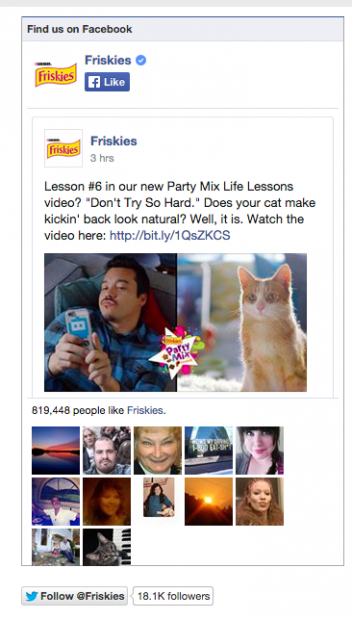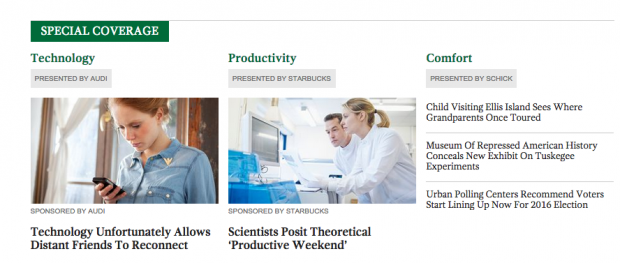Depending on who you ask, sponsored content could be many things. Though at its heart it’s a pretty basic concept — a blend of journalism and advertising that promotes a product or company in the form of an article or blog post (rather than a sidebar ad or other traditional commercial technique) – what it actually does in practice and how advertisers and publishers use it is subject of a great deal of discussion and debate.
It could be the publishing equivalent of striking gold, or finding the Holy Grail. It can be bizarre, evil, or promising. It might save journalism or it might end it forever. And it goes by many, many names, all designed to guide what you think of it and what it does.
Whatever you call it — advertorial, paid blogging, native advertising, an abomination that’s threatening to ruin ethical journalism as we know it — sponsored content is, for many bloggers, news agencies, and even companies, a great way to create and maintain a revenue stream that is relatively unobtrusive of the user experience and effective for the brands to pay to get their content embedded. And it can feel authentic and clever and useful and ethical, provided you do it right. Because truly, the difference between good sponsored content and disastrous sponsored content is the execution.
The absolute first and foremost rule of paid content is this: It must be clear that you have been paid to create it.
This is non-negotiable. If someone has crossed your proverbial palm with proverbial silver (which could be actual money or could also be more tactile, like free tickets or samples or other products) to say something about something – good, bad, or otherwise – you must make that clear. You can do that in a variety of ways, but it must be done.
The absence of disclosure is arguably the biggest issue that journalists and ethical professionals take with regard to sponsored content. In journalism school and while working as a reporter, we are instructed to always, always, always disclose any and all conflicts of interest or additional personal ties.
However, writing for the world to read is no longer the sole purview of those who have had to sit through lectures on payola, plugola, and the ethics of disclosure.
Mom bloggers often receive samples of products and write about them favorably without disclosing that they were provided the goods for free in exchange for the kind works, and tech writers who have worked or consulted for companies frequently tout their innovations or include them in listicles without noting that were ever on the payroll. Entire blog posts are dedicated to a thing or a place or an idea that, while on the surface may just seem like a glowing review, is actually a veiled advertisement presented like an authentic point of view.
This is easily avoided.
Disclosure of payment or relationship can be achieved in a single sentence at the top of a blog post – This post was paid for by A Company. For more information, check out their services – or with a kind of signifier in the headline or in even the header image. It takes almost no time, but for your credibility, it means the world.
Some websites build it into their web design. Consider the team at BuzzFeed, who have been extremely successful at creating sponsored content that appears right in line with their brand and voice, but is paid for by companies who want to advertise to their behemoth audience. The content itself is completely BuzzFeed-ish, but it’s clear who’s behind it. Here’s the actual article header:
BuzzFeed can offer bloggers and publishers a lot of insight into how to do paid content the right way.
Their sponsored content is often nearly indistinguishable from the kinds of posts their readers love — consider this roundup of design tips that’s actually a promotion for Aveno skincare — and doesn’t overtly sell the product, which makes it sharable and interesting.
Many advertisers want the ads themselves to be more sales-y. As a publisher, it’s in your best interest to push back some and make other offerings, like using your social widget to directly link to their social media accounts. Your audience, as a rule, does not want to share your advertising. They will, however, share your content that also happens to be advertising, which means the best advertorial is also content that is valuable on its own.
Remember that exposure, not necessarily transactions, should be the main goal when experimenting with content marketing. Even if the click-throughs to the product aren’t super high, what you’re offering as a publisher is the exposure to your audience and, if they share it, to their audience, as well.
Similarly, the Onion — who even have their own in-house ad agency — denote their sponsored content with additional flags on the site. This is probably one of the safest, easiest ways to ensure that you’re keeping your readers informed about the source of the content they’re getting.
The Onion also does a great job of incorporating the products they’re advertising with content that, again, is enjoyable in and of itself.
Sponsored content, native advertising, and its various brethren are still relatively new. As of 2014, many people didn’t even realize that they were looking at paid content most of the time. However, those who are aware of it know what they’re looking for. Today’s consumer is exceptionally skeptical about marketing, and appreciate authenticity in advertising. Rather than trying to dupe readers by keeping sponsorships a secret, you’re better off being extremely apparent in your paid content, and mindful about the execution.
When done right, it’s a powerful mechanism. When done wrong, it’s unfortunate and unethical.







